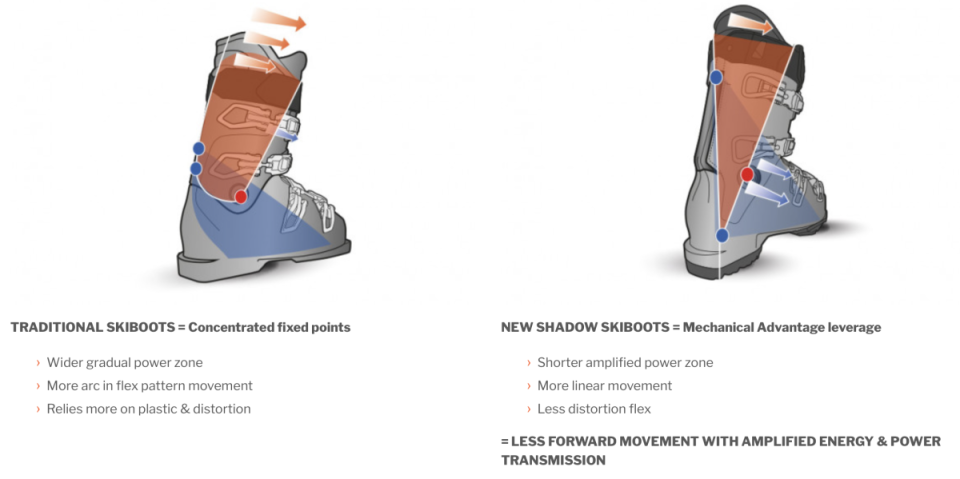Breaking Down the New Lange Shadow Boot
The Arena Media Brands, LLC and respective content providers to this website may receive compensation for some links to products and services on this website.
Last winter Lange announced their new Shadow series of boots as the next progression for high-performance inbounds ski boots. The Shadow uses two new technologies, dubbed “Suspension Blade” and “Dual Pivot” to deliver a different-feeling ski boot experience. I dove, in depth, into how the Shadow skis in our full review. The short version is: this boot feels really different, in a good way. Lange claims it lets you ski harder with less effort, and after skiing the Shadow with some big, demanding skis, I’m inclined to agree. So, how do those new technologies actually work, and what’s different about the construction of this boot?
What Lange Says
According to Lange, the combination of the Suspension Blade and Dual Pivot on the Shadow line of boots create four main advantages:
Enhanced leverage = more power with less effort
Suspension absorption and vibration damping
Increased rebound
Consistent flex
Those are all great things for ski boots to have, and most new alpine boot technologies claim to improve one or all of those aspects of the ski experience. But the Shadow uses some visually different design elements to achieve those goals.
I’m usually skeptical of the mockups brands provide when they announce changes to their lineup. They often exaggerate and overstate incremental changes. But, if you tasked me to illustrate the difference in how the Shadow feels from more traditional alpine boots, I’d probably come up with something similar to Lange’s illustration. Ski boots act as levers, translating forces from our feet and legs to our skis, and the Shadow is a differently shaped lever, with different pivot points, as illustrated here.

Image: Lange
Inside the Lange Shadow
As we’ve already established, I don’t think Lange is being too hyperbolic when they claim that this boot requires less input to drive skis. So, we pulled out the allen set and took it apart, to see what this Suspension Blade and Dual Pivot actually look like.
Here’s what the Suspension Blade looks like from the outside. I’ve included one of my favorite “traditional” alpine boots, the Fischer RC4 for reference.

It’s easy enough to pull apart the Suspension Blade linkage. A 2.5 mm allen releases the screw, and then the whole bracket and elastomer pop out. The elastomer is just a soft rubber part of a certain hardness (durometer) that controls how much flex and play is in the system.

Lange says the elastomers will be swappable, and softer elastomers will be available to soften up the flex of a boot by approximately 10%. I’ve been skiing the Shadow with the stock elastomers and have really enjoyed how they make it feel.

With the Suspension Blade bracket removed, it’s time to take a 3mm allen to the dual pivots. All hardware is secured by captured t-nuts on the backside, making this very easy. Remove the bolts from the lower pivots and you can see the “D” shaped recess the elastomer floats them in.

Remove the main pivot bolts and you can easily peel the cuff off from the clog. Don’t lose the pivot elastomers. If you drop them on the floor, your dog might think they’re a snack, don’t ask me how I know!

With the cuff removed, it’s easy to see how simple, but fundamentally different the Shadow’s shell is from a traditional overlap boot. The cuff overlaps much further down the clog of the boot, and the Suspension Blade reaches much higher up the cuff than a regular alpine boot. In short, this overlap boot has more overlap than most overlap boots.

The Suspension Blade, despite its name, isn’t stiff and springy, it’s soft, like the rest of the boot, but while disassembling the boot it’s obvious how much of an effect it has on both forward and backward flex.
My hunch is that if this boot had solid connections, with no float thanks to the elastomers, it would be absurdly stiff. There’s so much overlap here, and the Suspension Blade is in tension when you lean forward to flex the boot, I’d bet that it would be absurdly powerful and unforgiving without the play the elastomers control.

It almost feels like there’s a disconnect between how different the Shadow feels on snow, vs how simple it is when taken apart. Sure, it’s very different from traditional overlap boots, but the components used to create that difference aren’t that exotic. Honestly, that probably bodes well in terms of user-serviceability down the road. It’s very easy to swap or replace elastomers. It took me around five minutes to take one boot fully apart and put it back together. It’s not the type of thing I’d try in the ski resort parking lot, but it is the kind of thing I could easily do at a table in the lodge.

In Conclusion
The Lange Shadow is the rare product that makes big claims about being a step in a different direction from the established category, and then backs those claims up. The technology that makes that possible is relatively simple, and easy to work on, which is a win for shops and skiers. That makes for a potent combination for anyone looking for a powerful, easily-controlled alpine ski boot.

